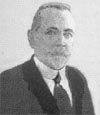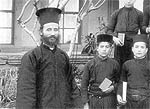

|
Sights - Chania Prefecture - Akrotiri |
|
|
Agia Triada Monastery |
|
|
Simonellis' description |
| Vittorio Simonelli (1860-1929)
was born in Arezzo, Italy. At the age of 15 he was taken in at the university of
Pisa as a science student. At the age of 29 he became a senior lecturer of
geology and palaeontology at this university. After a journey abroad, to
Bavaria, he was in 1891 employed at the university of Bologna, from where
he in 1893 made
his scientific journey to Crete.
|
|
||
| The Greek edition, translated
by Ioanna Fountoulaki, was
published in 1996 and is
the basis of my translation.
|
|||
| After Korakies the terrain is
sloping slightly downwards to the north and is covered with
some low and hairy plants, sending out an intense smell, as from incense,
while being burned under the sultry sun. For quite a long stretch there
are almost no trees, neither cultivated nor wild. Not until after
Plakoures - a village apparently named after the large flat lime stones in
its surrounding area - you see some rows of olive, almond and carob trees.
|
|||
| Time passes
quickly, but we proceed only
slowly, as we often pause to examine every stone, every plant and every
insect that we find on our way. Night had therefore fallen when we arrived
at the Agia Triada monastery. This holy building resembles a fortress,
especially when you see its silhouette rising over the olive trees in the
darkness. A four-sided building with high and strong walls is surrounding
the court, in the middle of which the white church, built by the Venetians
in 1631, dominates.
|
|||
| A well-fed man in black clothes
comes to meet us at the entrance and greets us with the traditional kalos
orisate (welcome). With his long beard he looks like a personification
of a mythological river-god. Around his big stomach is wound a long purple
sash - suitable to hide pistols rather than crosses. This is igoumenos
(the abbot) as his title is, i.e. the monastery superintendent. He led us
into a large hall, furnished with low and very big peasant sofas. There
was also a piece of furniture looking like a money chest, plated with iron,
and a small bookcase holding at the most 50 books. In the middle of a wall
there was a colour portrait of sultan Abdul Hamid, with a daydreamer's
glance turned towards a misty picture of Kiev. What a lot of curses this
cheap replica must have heard every day!
|
|||
| Into the reception room came a
brother, a kalogeros, as they called him, wearing a pair of
breeches, long boots and a black mantili around his head. He was carrying a tray with all the necessaries for a
small reception-party: small glasses of mastic, cups with the usual coffee
grains, cold water and lukumis, a kind of cakes made of flour and sugar,
soft, transparent and aromatic, and in no way inferior to the
"grand" cakes in Europe.
|
|||
| As we did not speak the
language, we escaped a whole lot of complimenting. In stead we threw
ourselves on the refreshments, while a veritable procession of both
ordained monks and other monks made their appearance, bidding us welcome
with their hand on their heart. They were all athletically built, which
shows that the numerous periods of fasting in the orthodox faith had not
been able to break them. They had determined and proud faces - despite
their effeminate hairstyle - and their eyes flashed like sword blades. Their charisma showed a
kind of military resolution, and their expressions resembled the warriors
of antiquity. They seemed to be ready to leave their holy duties and take
up arms in case of rebellion. They were brave men who - through their
desire to kill Turks - were ready to deny themselves a place in paradise.
|
|||
| They showered on us
a curiosity and a
talkativeness, characterizing usually only women. But when they could not
get any answers from us, who were dumb
as fish, they turned
to
Kela´dis with a stream of questions about us.
They put their hands down into the boxes, in which Cecconi had locked his
small animals; they rummaged in the botanist's things, and laughing loudly,
they showed to each other the instruments I used for my geological
research. In the meantime the rest of the monastery's inhabitants were
returning from the fields. New monks appeared in the doorway, while we saw
the pupils from the monastery school looking in through the window with
sparkling eyes from the darkness outside in the court.
|
|||
| The supper was a long time coming, and the waiting time appeared
very long to us. Agia Triada's patient cook made me send kind thoughts to
his colleagues in the Italian monasteries.
|
|||
| Fortunately a young monk who spoke an excellent French, came and kept me
company. (...)
|
|
||
| During my conversation with the young monk, I became aware of how great the
difference is between the present monks in Crete and the monks that
Tournefort met, who "as
simple and unlettered are only occupied with cultivating the land".
I also understood the monks' important part in the rebel movement of Crete.
They are not just favourably disposed hands, always ready to take up arms
when necessary, but they are in fact the very soul and brain behind the
liberation organization.
|
|||